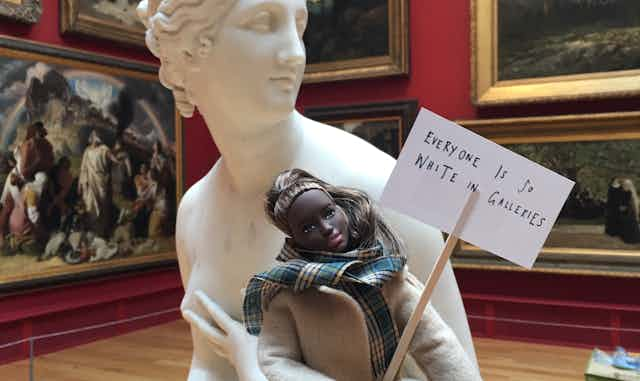You may be surprised to learn that Barbie – lollipop-headed cultural icon and instrument of female oppression – has thrown off the shackles of the patriarchy’s archetypal dumb blonde to become a feminist art warrior blasting the hallowed halls of the world’s great art institutions. But it’s true.
Say hello to ArtActivistBarbie (AAB), whose modus operandi is small signs, big questions and a fabulous wardrobe. With her inviting call to arms, “Refuse to be the muse!” this fierce new incarnation of Barbie is helping to challenge art galleries and museums worldwide about their woeful lack of women and other minorities in their collections, and reluctance to consider the female gaze.
Thousands follow her on Twitter, enjoying her playful disruption and creative interventions which ask questions and raise issues about gender and the inequalities in many art collections. So, where did ArtActivistBarbie come from and where did she find those couture creations she carries off with such panache?

I use the arts to explore issues of inequality and social injustice, and research the use of objects and the potential of museums and galleries to be places which can educate for change. In 2018, I decided to do this using the most famous doll in Western culture: Barbie. I took a group of students to my local art gallery, gave them all a Barbie doll and asked them to “hack” the gallery by intervening and posing their doll with commentary on a placard.
By subverting Barbie’s bland stereotype of femininity and employing her idealised beauty and unrealistic figure, we were able to draw attention lightly to serious gender issues in a way that was both humourous and thought provoking.
It was a great success and had a big impact on both my students and gallery visitors. Afterwards I realised I had found the perfect way to engage a wide range of people in gender politics. And so, ArtActivistBarbie was born.

The problem with art
Many famous art galleries and museums, particularly those with historical collections, offer a very singular, male-dominated view of art world. The artworks regarded as historically most important present the world through a male perspective – the “male gaze”.
In the 1980s art activists Guerrilla Girls started to draw attention to this extreme male bias and gender discrimination in the art world, successfully protesting in the US. With smart, cutting messages delivered via large-scale billboard works, the Guerilla Girls sought to name and shame the art world for its unapologetic disregard for women and other minorities in art.

Now, ArtActivistBarbie is in turn revealing the practices of galleries and museums and their displays of male-commissioned, male-produced and male-collected works of art which represent centuries of male power, privilege and domination. It’s important and necessary work because art galleries and museums are trusted and influential places that play a part in shaping our identities, our sense of self and our sense of possibility. It is only right that they demonstrate more balance by reflecting the lives and experience of women, ethnic minorities and other under-represented groups.
This is how we do it
ArtActivistBarbie reports on her activism through Twitter. In April 2020 alone, the account reached 1.9 million impressions. Her main line of enquiry, “Where are all the female artists?” is highlighted through a series of staged “events”. One of AAB’s first public interventions was to point out the 2,300 works by men and 21 works by women in the National Gallery in London. AAB aims not only to highlight such gender gap statistics, but also their societal and historical context, challenging the reasons, biases and prejudices behind them.

The Barbies are artfully arranged to echo artworks, sometimes in parody but also in homage to female artists or to celebrate the positive representation of women. Curatorial labels, wall texts and statements are questioned, challenged and often mocked.
The visual aesthetic of the work is important and AAB’s wardrobe is much admired on Twitter. She wears vintage pieces lovingly made for my own Barbie in the 1970s by my mother. At 93 she can longer make the pieces, so my sister has taken up the couture mantle for AAB. Drawing on the perceived Barbie glamour aesthetic, the clothes declare that an interest in style does not preclude feminism or activism.
The reaction of gallery visitors has been hugely positive and encouraging. Young women spot her in a crowded room, delighted by the feminist messages and always take photographs. I have heard groups discussing gender issues not only in art, but also in wider society. Sometimes people talk about the work to complete strangers next to them. Many are surprised, shocked even, by AAB’s placards. Some express their thanks. There are varied reactions from gallery staff too. Some observe approvingly, some call security.
Keeping up pressure
There are promising signs of change. In March 2019, the National Gallery in London posted a video on its website stating it had become increasingly concerned about the gender gap in art history and wanted to respond to growing pressure from social media about women and their collection.
In April, art critic Waldemar Januszczak tweeted that ArtActivistBarbie had been filling his timeline with complaints that his Sunday Times History of Art poster (which AAB tweeted as “His Story of Art”) did not include enough women artists. “Mea culpa. It’s a fair point,” he replied, and profiled ten women artists “as partial recompense”.
In early May, the London’s National Portrait Gallery announced the creation of a new post titled, Curator: Missing Narratives on Women, to fill the gaps in their collection. And now, ArtActivistBarbie has been asked to guest curate an exhibition in the north of England. The voices are growing and big art institutions are realising they can no longer blame history. It’s time to redress the balance. Stylishly, of course.

